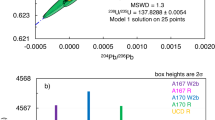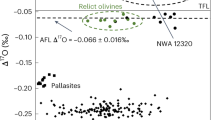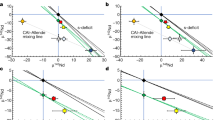Abstract
VARIATIONS in the isotopic abundance of magnesium (78.6% 24Mg, 10.1% 25Mg, 11.3% 26Mg) have been sought1,2 in meteorites because of the possible addition of radiogenic 26Mg by the decay of 26Al. This short-lived nuclide (half-life 7.4×105 yr) is formed by proton bombardment of light elements3 and is of particular interest in theories of nucleosynthesis and heat generation during the early history of the Solar System. Analysed material must have a high Al/Mg ratio to avoid the dilution of any radiogenic 26Mg by common Mg. Consequently, previous workers have chosen mainly feldspars from basaltic achondrites and metamorphosed chondrites. The apparent absence of excess 26Mg in such meteorites is, however, not suprising, because the condensation of chondritic material from the solar nebula now seems4 to predate its later metamorphism by some 80 Myr, and the magmatic activity that produced the basaltic achondrites is younger still. Thus, the feldspars that formed as a result of these processes would incorporate aluminium that was separated from a nucleo-synthetic event by at least 80 Myr and because of its short halflife in-sufficient 26Al would remain to generate a detectable 28Mg anomaly.
This is a preview of subscription content, access via your institution
Access options
Subscribe to this journal
Receive 51 print issues and online access
$199.00 per year
only $3.90 per issue
Buy this article
- Purchase on Springer Link
- Instant access to full article PDF
Prices may be subject to local taxes which are calculated during checkout
Similar content being viewed by others
References
Clark, W. B., de Laeter, J. R., Schwarcz, H. P., and Shane, K. C., J. geophys. Res., 75, 448 (1970).
Schramm, D. N., Tera, F., and Wasserburg, G. J., Earth planet. Sci. Lett., 10, 44 (1970).
Schramm, D. N., Astrophys. Space Sci., 13, 249 (1971).
Gray, C. M., Papanastassiou, D. A., and Wasserburg, G. J., Icarus, 20, 213 (1973).
Clayton, R. N., Grossman, L., and Mayeda, T. K., Science, 182, 485 (1973).
Marvin, U. B., Wood, J. A., and Dickey, J. S., jun., Earth planet. Sci. Lett., 7, 346 (1970).
Catanzaro, E. J., Murphy, T. J., Garner, E. L., and Shields, W. R., J. Res. natn. Bur. Stand., 70 A, 453 (1966).
Clarke, R. S., jun., Jarosewich, E., Mason, B., Nelen, J., Gomez, M., and Hyde, J. R., Smithsonian Contrib. Earth Sci., 5 (1970).
Podosek, F. A., and Lewis, R. S., Earth planet. Sci. Lett., 15, 101 (1972).
Clement, S., and Compston, W., Int. J. mass Spectrom. ion Phys., 10, 323 (1972/73).
Author information
Authors and Affiliations
Rights and permissions
About this article
Cite this article
GRAY, C., COMPSTON, W. Excess 26Mg in the Allende Meteorite. Nature 251, 495–497 (1974). https://doi.org/10.1038/251495a0
Received:
Revised:
Issue Date:
DOI: https://doi.org/10.1038/251495a0
This article is cited by
-
Early planetary processes and light elements in iron-dominated cores
Acta Geochimica (2022)
-
Preparation of large-area isotopic magnesium targets for the 25Mg(p,γ)26Al experiment at JUNA
Nuclear Science and Techniques (2020)
-
Determination of the 25Mg(p, γ)26Al resonance strength at E c.m.=58 keV via shell model calculation
Science China Physics, Mechanics & Astronomy (2015)
-
Radioactive Cs capture in the early solar system
Scientific Reports (2013)
-
4. Building of a Habitable Planet
Earth, Moon, and Planets (2006)
Comments
By submitting a comment you agree to abide by our Terms and Community Guidelines. If you find something abusive or that does not comply with our terms or guidelines please flag it as inappropriate.



